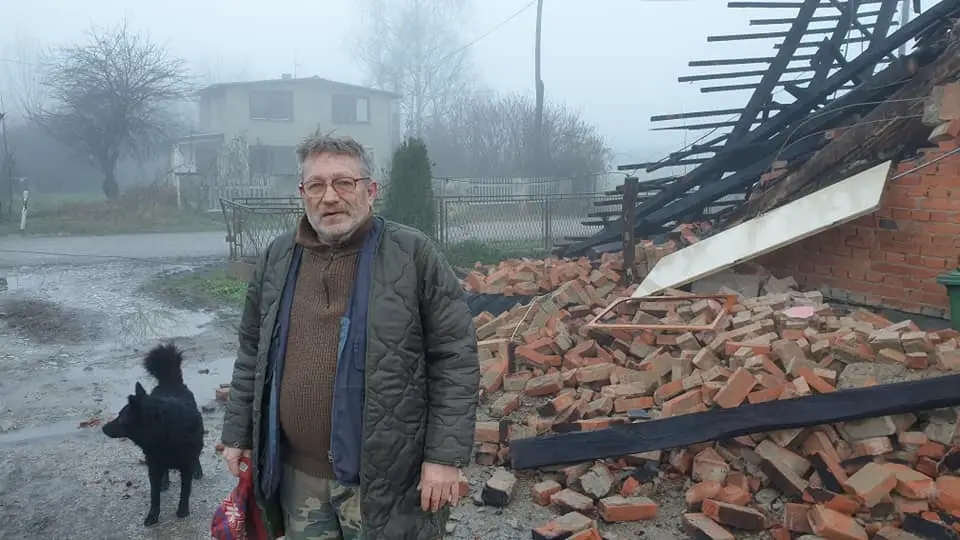The SECOND anniversary of the devastating earthquake in Banija came with the dissatisfaction of the victims, but also of the participants in the reconstruction, which Prime Minister Andrej Plenković called “unbelievably slow,” writes Index. Though we briefly covered the complex topic in A Week in Croatian Politics, read along for a more detailed overview.
Two years ago, on Tuesday, December 29, at 12:19 p.m., the area around Petrinja was hit by a devastating earthquake of magnitude 6.2, followed by a series of other earthquakes. The earthquake took the lives of seven people, leaving behind sad scenes of destroyed houses, commercial facilities, and public buildings in Petrinja, Sisak, Glina, and surrounding towns.
Many citizens from all over Croatia came to the aid of the residents who lost their homes in an instant on the same day, collecting and donating food, preparing meals, and clearing the ruins…
Citizens themselves brought food and other necessities in their cars, numerous volunteers and groups of younger people with shovels were seen in the earthquake-affected area helping the local population clear the terrain.
Two years later, the consequences of the earthquake are still apparent in many unrenovated houses in numerous villages and in Glina and Petrinja, where the reconstruction of the city centre has not started, but scaffolding and work on the first of 26 buildings are expected early next year.
In the area of Glina, 700 containers have been placed in which people from houses with red and yellow stickers (poor state of the buildings) are still waiting for structural renovation or replacement houses. Among them are people who do not have their own properties, so they are waiting for some other suitable accommodation.
In the Petrinja area, which has lost 5,000 residents since the last census, many people live in container settlements and containers next to their houses. Currently, about 1,600 of them are in the entire city and 212 in three container settlements.
The residents of the destroyed homes are dissatisfied because most of them are still waiting in containers to return to the renovated houses. The completion of the renovation of the houses is not yet in sight, though, as there are still many bureaucratic windmills left to fight. The government members are dissatisfied because the planned structural renovation of houses and the construction of replacement houses and residential buildings has not gained the expected momentum, despite the amendments to the Law on Reconstruction from October 2021, in which great hopes were placed.
Plenković’s recent statement that the reconstruction of Banija “is going unbelievably slowly” fueled speculations about the resignation of Minister Paladina, who took up his post in March after the resignation of former Minister Darko Horvat. However, Paladina claimed that the “unbeleivably slow reconstruction” statement did not apply to him and was misinterpreted. The statement refers, he clarified, to the fact that the structural renovation of houses and buildings and the construction of replacement houses are not progressing at a sufficiently high-quality pace, which he has been saying for months.
“Only when we start renovating 100 houses a month we can be satisfied. I’ve been saying this for more than three, four months. The Prime Minister’s statement refers to that part of the renovation that must be accelerated,” he said.
Number of houses built in two years – 6
Only a few were lucky enough to return to their homes because, so far, the state has secured that all of six replacement houses are built in the entire county. Another 109 are currently under construction, while 16 multi-apartment buildings are under construction as part of the competitiveness and cohesion operational program.
Not a single building was renovated in the organised structural renovation, and the Central State Office, responsible for that county, completed the public tender procedure for 50 structural renovations.
According to statements from the area, most buildings were renovated thanks to donations. For example, in the area of Glina, 45 buildings were bought or built from donations, while the state has so far built six houses in the entire county, of which only one is in the area of Glina.
In the Zagreb area, which was hit by an earthquake measuring 5.5 on the Richter scale on Sunday, March 22, 2020, at 6:24, 25 structural renovations are underway, while 14 structural and 2227 non-structural renovations have been completed.
The renovation of public buildings is going better. From the Solidarity Fund, which is open until June 30 next year for the reconstruction of public buildings, 10 percent of the amount was realised in March, and now that share has risen to 40 percent.
Claims were submitted for compensation in the amount of HRK 2.6 billion.
New measures tackling numerous obstacles
Obstacles in the renovation of houses are numerous, from complicated “paperwork” and the application process to the lack of labour, rising prices of construction materials, and property-legal relations.
At the end of July, the Ministry adopted a new Program of Measures for the Reconstruction of Earthquake-Damaged Buildings, which improved the model of financial assistance, i.e., self-renovation, according to which the property owner who opts for the self-renovation model assumes the choice of the contractor and supervision. It also allows the owner to ensure the creation of the architectural design.
The most significant measure is the payment of advances to users who cannot provide their own funds. For example, for the first phase of self-renovation, an advance payment for the costs of creating a project for structural self-renovation of houses, as well as an advance for the execution of works worth 25 percent of the financial aid, is possible, while for buildings, the payment of the entire amount of financial assistance is possible.
For more, make sure to check out our dedicated News section.








